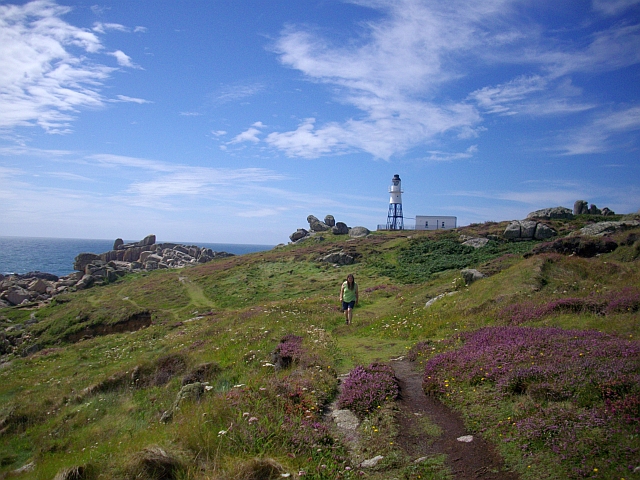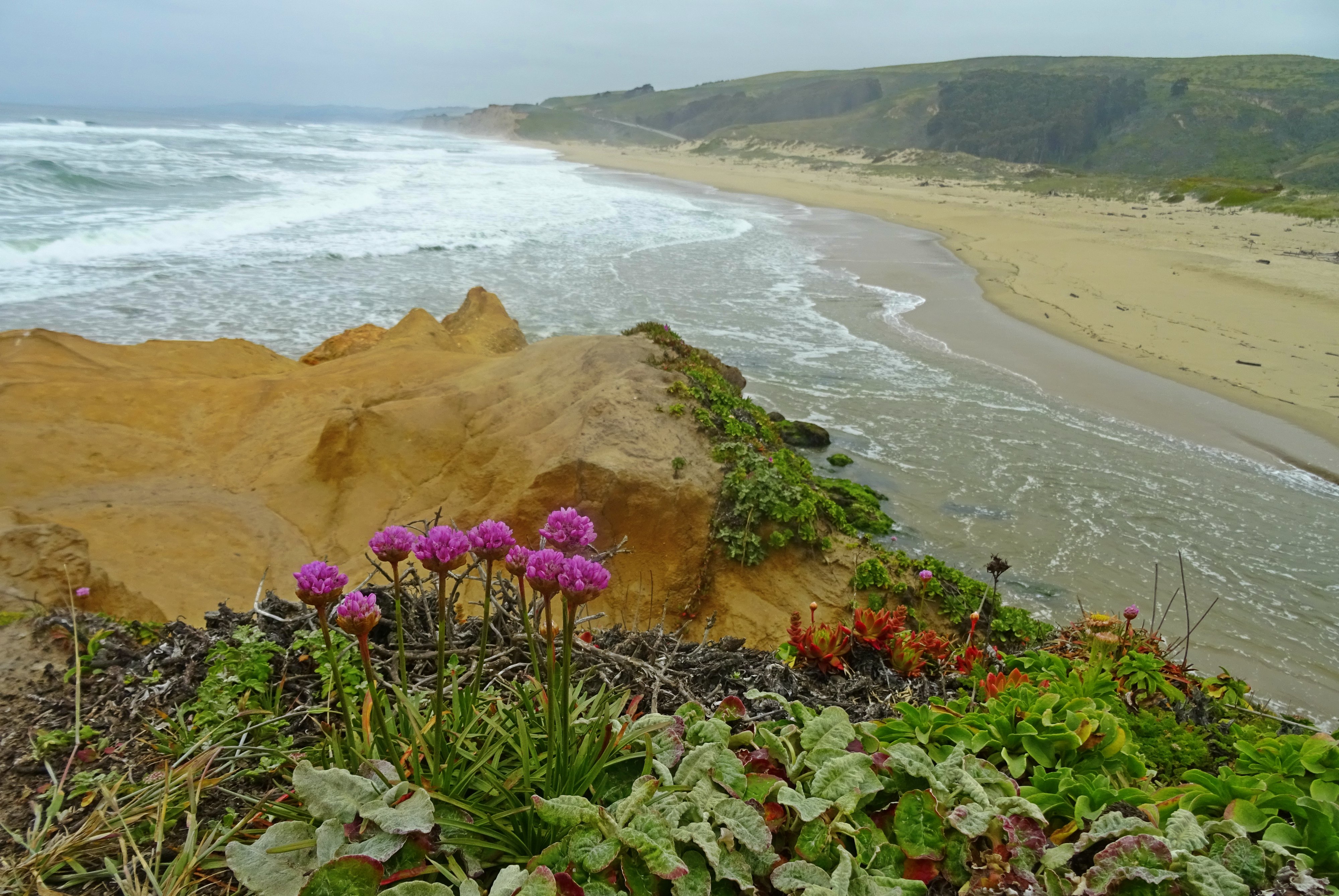|
Peninnis Head
Peninnis Head ( kw, Penn Enys, meaning ''Island Head'') is the southernmost point of St Mary's, Isles of Scilly. The headland is within the Isles of Scilly Area of Outstanding Natural Beauty and part of the Heritage Coast. It is also a Geological Conservation Review site for its Quaternary geomorphology and was first designated a Site of Special Scientific Interest (SSSI) in 1971 for both its biological and geological interests. On the tip of the headland is a squat lighthouse built in 1911 by Trinity House as a replacement for the 17th century lighthouse on St Agnes. The ''Gilstone'', a prominent rock off the eastern side of Peninnis Head, should not be confused with a rock of the same name in the Western Rocks. Geology The headland is composed of coarse–grained Hercynian granite which has weathered to form cairns and natural sculptures with names such as the Pulpit Rock. In places head deposits have accumulated and thin podzolic soils have formed over the granite which ... [...More Info...] [...Related Items...] OR: [Wikipedia] [Google] [Baidu] |
Glacial
A glacial period (alternatively glacial or glaciation) is an interval of time (thousands of years) within an ice age that is marked by colder temperatures and glacier advances. Interglacials, on the other hand, are periods of warmer climate between glacial periods. The Last Glacial Period ended about 15,000 years ago. The Holocene is the current interglacial. A time with no glaciers on Earth is considered a greenhouse climate state. Quaternary Period Within the Quaternary, which started about 2.6 million years before present, there have been a number of glacials and interglacials. At least eight glacial cycles have occurred in the last 740,000 years alone. Penultimate Glacial Period The Penultimate Glacial Period (PGP) is the glacial period that occurred before the Last Glacial Period. It began about 194,000 years ago and ended 135,000 years ago, with the beginning of the Eemian interglacial. Last Glacial Period The last glacial period was the most recent glacial period ... [...More Info...] [...Related Items...] OR: [Wikipedia] [Google] [Baidu] |
Armeria Maritima
''Armeria maritima'', the thrift, sea thrift or sea pink, is a species of flowering plant in the family Plumbaginaceae. It is a compact evergreen perennial which grows in low clumps and sends up long stems that support globes of bright pink flowers. In some cases purple, white or red flowers also occur. It is a popular garden flower and has been distributed worldwide as a garden and cut flower. It does well in gardens designed as xeriscapes or rock gardens. The Latin specific epithet ''maritima'' means pertaining to the sea or coastal. Subspecies * ''Armeria maritima'' subsp. ''azorica'', Franco * ''Armeria maritima'' subsp. ''californica'', synonym: ''California Seapink'' *''Armeria maritima'' subsp. ''elongata'', synonym: ''Tall Thrift,'' Gaston Bonnier. *''Armeria maritima'' subsp. ''maritima'' *''Armeria maritima'' subsp. ''purpurea,'' synonym: ''Armeria purpurea'' W.D.J.Koch, (W.D.J.Koch) Á.Löve and D.Löve *''Armeria maritima'' subsp. ''sibirica'', synonym: ''Sibe ... [...More Info...] [...Related Items...] OR: [Wikipedia] [Google] [Baidu] |
Holcus Lanatus
''Holcus lanatus'' is a perennial grass. The specific epithet ' is Latin for 'woolly' which describes the plant's hairy texture. Common names include Yorkshire fog, tufted grass, and meadow soft grass. In North America, where it is an invasive species, names include velvet grass and common velvet grass.Hubbard, C. E. ''Grasses''. Harmondsworth: Penguin Books. 1976. Yorkshire Fog. Garden Organic. Henry Doubleday Research Association (HDRA). In parts of northern Europe the grass is a common native species and a hardy pasture grass. Characteristics and hybrids  ''Holcus lanatus'' has velvety grey-green leaves. ...
''Holcus lanatus'' has velvety grey-green leaves. ...
[...More Info...] [...Related Items...] OR: [Wikipedia] [Google] [Baidu] |
Festuca Rubra
''Festuca rubra'' is a species of grass known by the common name red fescue or creeping red fescue. It is widespread across much of the Northern Hemisphere and can tolerate many habitats and climates. It is best adapted to well-drained soils in cool, temperate climates; it prefers shadier areas and is often planted for its shade tolerance. Wild animals browse it, but it has not been important for domestic forage due to low productivity and palatability. It is also an ornamental plant for gardens. Description ''Festuca rubra'' is perennial and has sub-species that have rhizomes and/or form bunchgrass tufts. It mainly exists in neutral and acidic soils. It can grow between 2 and 20 cm tall. Like all fescues, the leaves are narrow and needle like, making it less palatable to livestock. The swards that it forms are not as tufted as sheep's fescue (''Festuca ovina'') or wavy hair grass (''Deschampsia flexuosa''). The tufted nature is what gives the grass its springy characterist ... [...More Info...] [...Related Items...] OR: [Wikipedia] [Google] [Baidu] |
Thymus Polytrichus
''Thymus praecox'' is a species of thyme. A common name is mother of thyme, but "creeping thyme" and "wild thyme" may be used where ''Thymus serpyllum'', which also shares these names, is not found. It is native to central, southern, and western Europe. Classification ''Thymus praecox'' is in the genus ''Thymus'' belonging to the ''Serpyllum'' section. It has sometimes been reclassified as ''T. polytrichus.''Brickell, C. & Zuk, J., Editors-in-Chief. ''The American Horticultural Society A-Z Encyclopedia of Garden Plants,'' First American Edition. (New York: DK Publishing, Inc., 1997; ). Subspecies and cultivars ''Thymus praecox'' subspecies and cultivars include: * ''Thymus praecox'' subsp. ''praecox'' ** ''Thymus praecox'' 'Doone Valley' (recently reclassified as a hybrid under the name ''Thymus'' 'Doone Valley') ** ''Thymus praecox'' 'Minus' ** ''Thymus praecox'' 'Pseudolanuginosus' * ''Thymus praecox'' subsp. ''arcticus'' (sometimes classified as ''Thymus polytrichus'' subsp ... [...More Info...] [...Related Items...] OR: [Wikipedia] [Google] [Baidu] |
Scilla Verna
''Scilla verna'', commonly known as spring squill, is a flowering plant native to Western Europe. It belongs to the squill genus ''Scilla''. Its star-like blue flowers are produced during the spring. It is a small plant, usually reaching 5-15 centimetres in height. It is perennial and grows from a bulb which is 10-15 millimetres across and ovoid in shape. Two to seven leaves grow from the base of the plant; they are long and narrow, measuring 3–20 cm by 2–5 mm. The flowers grow in a dense cluster of two to twelve at the top of the upright stem. They are scentless and have six violet-blue tepals, 5–8 mm long. Each flower has a 5–15 mm long, bluish bract at the base. The seeds are ovoid and black. The diploid number of chromosomes is 20 or 22. The plant occurs from Portugal north through Spain, France, Great Britain (particularly the west coast) and Ireland (mainly along the east coast), reaching as far as the Faroe Islands and Norway. It is found i ... [...More Info...] [...Related Items...] OR: [Wikipedia] [Google] [Baidu] |
Lonicera Periclymenum
''Lonicera periclymenum'', common names honeysuckle, common honeysuckle, European honeysuckle, or woodbine, is a species of flowering plant in the family Caprifoliaceae native to much of Europe, North Africa, Turkey and the Caucasus. It is found as far north as southern Norway and Sweden. Description Growing to or more in height, it is a vigorous deciduous twining climber, occasionally keeping its old leaves over winter. In the UK it is one of two native honeysuckles, the other being ''Lonicera xylosteum''. It is often found in woodland or in hedgerows or scrubland. The tubular, two-lipped flowers, creamy white or yellowish in colour, may be flushed with pink or red on the outside and in bud, and are carried in showy clusters at the ends of the shoots. The flowers are highly scented by night, much less so by day. Ecology The plant is usually pollinated by moths or long-tongued bees and develops bright red berries. Dormice make summer nests for their young from honeysuckle b ... [...More Info...] [...Related Items...] OR: [Wikipedia] [Google] [Baidu] |
Rubus Fruticosus
''Rubus fruticosus'' L. is the ambiguous name of a European blackberry species in the genus ''Rubus'' in the rose family. The name has been interpreted in several ways: *The species represented by the type specimen of ''Rubus fruticosus'' L., which is also the type specimen of the genus ''Rubus''. This specimen is considered to match the species '' R. plicatus'', in ''Rubus'' subgenus ''Rubus'', section ''Rubus''. * Various species consistent with Linnaeus' original description of the species, which was based on a mixture of specimens now considered to match ''Rubus ulmifolius'' and ''R. plicatus'' *a species aggregate (group of similar species) ''Rubus fruticosus'' agg. (a ''nomen ambiguum'') that includes most (or rarely all) of a group called ''Rubus'' subgenus ''Rubus'' (or less often: ''Rubus'' section ''Rubus'' ensu latissimo): ** in a narrow sense, sometimes separated as the section ''Glandulosus'' (alternative name: subsection ''Hiemales''), with about 289 microspeci ... [...More Info...] [...Related Items...] OR: [Wikipedia] [Google] [Baidu] |
Ulex Europaeus
''Ulex europaeus'', the gorse, common gorse, furze or whin, is a species of flowering plant in the family Fabaceae, native to the British Isles and Western Europe. Description Growing to tall, it is an evergreen shrub. The young stems are green, with the shoots and leaves modified into green spines, long. Young seedlings produce normal leaves for the first few months; these are trifoliate, resembling a small clover leaf. The solitary flowers are yellow, long, with the pea-flower structure typical of the Fabaceae; they are produced throughout the year, but mainly over a long period in spring. They are coconut-scented. The fruit is a legume (pod) long, dark purplish-brown, partly enclosed by the pale brown remnants of the flower; the pod contains 2–3 small blackish, shiny, hard seeds, which are ejected when the pod splits open in hot weather. Seeds remain viable for 30 years. Like many species of gorse, it is often a fire-climax plant, which readily catches fire but re-g ... [...More Info...] [...Related Items...] OR: [Wikipedia] [Google] [Baidu] |
Pteridium Aquilinum
''Pteridium aquilinum'' (bracken, brake or common bracken), also known as eagle fern, is a species of fern occurring in temperate and subtropical regions in both hemispheres. Originally native to Eurasia and North America, the extreme lightness of its spores has led to it achieving a cosmopolitan distribution. Etymology Common bracken was first described as ''Pteris aquilina'' by Carl Linnaeus, in Volume 2 of his ''Species Plantarum'' in 1753. The origin of the specific epithet derived from the Latin ''aquila'' "eagle". In the reprint of the ''Flora Suecica'' in 1755, Linnaeus explains that the name refers to the image of an eagle seen in the transverse section of the root. In spite of this, the opinion has been forwarded that the name pertains to the shape of the mature fronds appearing akin to an eagle's wing. However, medieval scholars, including Erasmus, thought the pattern of the fibres seen in a transverse section of the stipe resembled a double-headed eagle or oak tree. Ta ... [...More Info...] [...Related Items...] OR: [Wikipedia] [Google] [Baidu] |
Erica Cinerea
''Erica cinerea'', the bell heather, is a species of flowering plant in the heath family Ericaceae, native to western and central Europe. The plant provides a great deal of nectar for pollinators. It was rated in the top 5 for most nectar production (nectar per unit cover per year) in a UK plants survey conducted by the AgriLand project which is supported by the UK Insect Pollinators Initiative. Description It is a low, spreading shrub growing to tall, with fine needle-like leaves long arranged in whorls of three. The flowers are bell-shaped, purple (rarely white), long, produced in mid- to late summer. The flowers are dry, similar in texture to the strawflower. The Latin specific epithet ''cinerea'' means "ash coloured". Distribution ''Erica cinerea'' is native to the west of Europe, where it is most abundant in Britain and Ireland, France, northern Spain and southern Norway. It also occurs in the Faroe Islands, Belgium, Germany, north-western Italy, and the Netherlands. ... [...More Info...] [...Related Items...] OR: [Wikipedia] [Google] [Baidu] |



.jpg)

